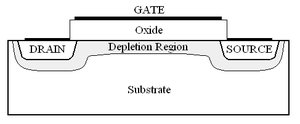CMOS: Difference between revisions
No edit summary |
No edit summary |
||
| (5 intermediate revisions by 3 users not shown) | |||
| Line 1: | Line 1: | ||
[[Image:Cmos.PNG|thumb|right|Side view of a CMOS transistor]] | |||
At the October 1968 International Electronic Devices Meeting in Washington, D.C., the [[Westinghouse Electric Corporation|Westinghouse Molecular Electronics]] division announced a new type of field-effect transistor, the CMOS (Complementary Metal-Oxide-Semiconductor). Its much lower power usage makes portable devices more viable, and enables efficient, low power, memory storage. | |||
Westinghouse presented two experimental MOS [[Transistors|transistors]]. The first was known as the MONTOS (metal-oxide-nitride-oxide semiconductor). It was made of silicon nitride and silicon dioxide, and it was noted for its ability to store all active, passive, and storage elements of a circuit on the same chip. But this device was only appropriate for read-only memory applications. | |||
The second model transistor, which ultimately became the new MOS standard, had a complementary MOS-bipolar structure. This approach was a marked improvement over previous chips, called MOSFETs (metal-oxide-semiconductor field-effect transistors), which placed vertical and lateral non-bipolar transistors on the same chip. The bipolar MOS was potentially ten times faster than the MOSFET. It also had the ability to operate as logic and shift-register elements with reduced interference. MOSFETs were driven by voltage, while the bipolar MOS ran on current, which marked an improvement in energy efficiency. | |||
< | The low power demands of bipolar CMOS transistors soon made them the industry standard as manufacturers began developing small electronic devices power by semiconductors. CMOS chips combined semiconductors with both positive and negative polarities. Because only one of its polarized circuits would operate at a time, the CMOS was efficient, making it a vital component in battery-powered machines like laptop computers. CMOS was also used to store the set-up parameters on personal computers and has been installed in digital cameras as an image-capture technology.<br> | ||
[[Category:Components,_circuits,_devices_&_systems]] | |||
[[Category:Integrated_circuits]] | |||
[[Category:CMOS_integrated_circuits_&_microprocessors]] | |||
Revision as of 14:04, 24 March 2014
At the October 1968 International Electronic Devices Meeting in Washington, D.C., the Westinghouse Molecular Electronics division announced a new type of field-effect transistor, the CMOS (Complementary Metal-Oxide-Semiconductor). Its much lower power usage makes portable devices more viable, and enables efficient, low power, memory storage.
Westinghouse presented two experimental MOS transistors. The first was known as the MONTOS (metal-oxide-nitride-oxide semiconductor). It was made of silicon nitride and silicon dioxide, and it was noted for its ability to store all active, passive, and storage elements of a circuit on the same chip. But this device was only appropriate for read-only memory applications.
The second model transistor, which ultimately became the new MOS standard, had a complementary MOS-bipolar structure. This approach was a marked improvement over previous chips, called MOSFETs (metal-oxide-semiconductor field-effect transistors), which placed vertical and lateral non-bipolar transistors on the same chip. The bipolar MOS was potentially ten times faster than the MOSFET. It also had the ability to operate as logic and shift-register elements with reduced interference. MOSFETs were driven by voltage, while the bipolar MOS ran on current, which marked an improvement in energy efficiency.
The low power demands of bipolar CMOS transistors soon made them the industry standard as manufacturers began developing small electronic devices power by semiconductors. CMOS chips combined semiconductors with both positive and negative polarities. Because only one of its polarized circuits would operate at a time, the CMOS was efficient, making it a vital component in battery-powered machines like laptop computers. CMOS was also used to store the set-up parameters on personal computers and has been installed in digital cameras as an image-capture technology.
